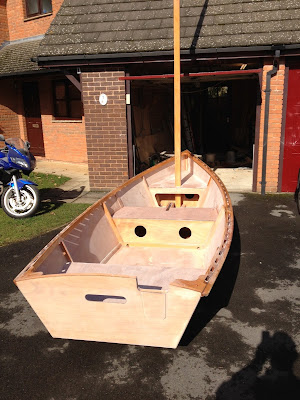In terms of mods I have no added a single toe-strap that runs from the middle seat to the aft seat and this really helps me to get weight out on the rail. We are still working on the best position for the crew but in stronger wind I think the crew may be able to get one foot under the strap but if it’s that windy we would probably go for a reefed sail.
Getting Sneaky to and from the water was getting to be a bit of a pain so I’m now keeping it at a sailing club in Portsmouth harbour, this makes life much easier and I’m now taking part in their summer evening racing series. It’s a bit of a learning curve as not only do we need to work out a handicap with the club but I’m also having to get used to handling the boat with a bunch of other dinghies around. It’s all great fun and my good friend Dan is keen to sail with me and really knows what he’s doing. We are racing initially with a handicap of 1145 which in theory makes us the fastest boat in the “slow” fleet, it sounds like a reasonable starting point and we will just have to see how we get on in comparison to the other boats.
We had a practice last night with Dan, perfect summer evening, warm with a gentle 6-8k kts breeze. Well worth doing as we played with the sail controls and in the light airs found that we really needed to play with the downhaul much more than previously, it has a huge effect! We also released some of the tension in the yard, I was pulling the top corners out too much but this may need to be re-tensioned in stronger winds. Dan also showed me how we can steer the boat by heeling it, helps with tacking as the rudder is used less so less loss of speed. The boom is too heavy really, it’s not a problem in stronger winds but in light winds it pulls the leech down and creates a crease from the front of the yard to the rear of the boom that can be removed with more downhaul but that then flattens the sail too much. I have always known the boom was over-weight so it’s not a surprise, I’m going to remove some more material from the boom, perhaps drill a bunch of holes in it J.
That’s all for now folks, sorry no pics this time, I’ll try and get some of us racing.
















































